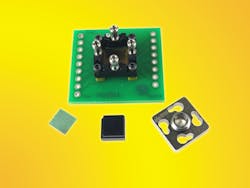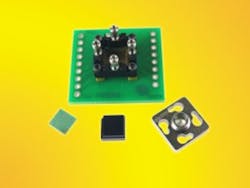Ironwood debuts 40-GHz ATE socket for BGA packages
Eagan, MN. Ironwood Electronics has introduced a new BGA socket design using a high-performance elastomer contactor. The socket offers low inductance and high endurance, and it can serve wide-temperature-range applications. The SMP-BGA-8007 socket is designed for 6.064 x 6.464-mm package sizes and operates at bandwidths up to 40 GHz with less than 1 dB of insertion loss.
The socket is also designed to dissipate few watts with an aluminum compression screw assembled on the swivel lid. It can be customized up to 100 W with a modified fin design on top of the screw and by adding an axial-flow fan. The contact resistance is typically 15 mΩ per pin. The socket connects all pins with 40-GHz bandwidth on all connections. The socket is mounted on the target PCB with no soldering and usesThe SMP-BGA-8007 socket is constructed with a high-performance and low-inductance elastomer contactor. The temperature range is -55°C to +150°C. The pin self-inductance is 0.10 nH, and mutual inductance is 0.007 nH. Capacitance to ground is 0.069 pF. Current capacity is 4 A per pin. It comes with a protective plunger matrix (a gold plated copper cylinder) that sits on top of the conductive silver columns. This plunger matrix protects the conductive silver columns from contamination due to various solder ball interfaces. A quickly replaceable plunger matrix enables minimal downtime during final production test. Silver column with plunger matrix contact is rated for >500k cycles.
Pricing for the SMP-BGA-8007 is $2,700 each in quantities of 5.
About the Author

Rick Nelson
Contributing Editor
Rick is currently Contributing Technical Editor. He was Executive Editor for EE in 2011-2018. Previously he served on several publications, including EDN and Vision Systems Design, and has received awards for signed editorials from the American Society of Business Publication Editors. He began as a design engineer at General Electric and Litton Industries and earned a BSEE degree from Penn State.

